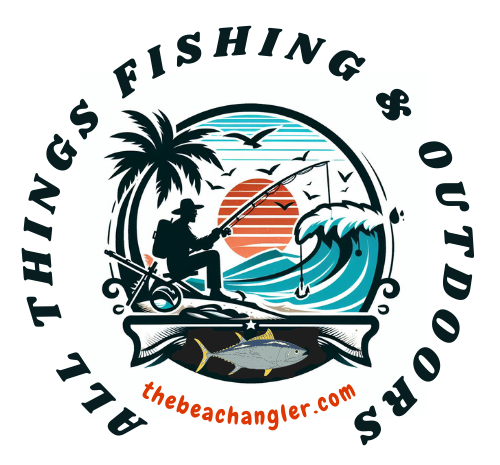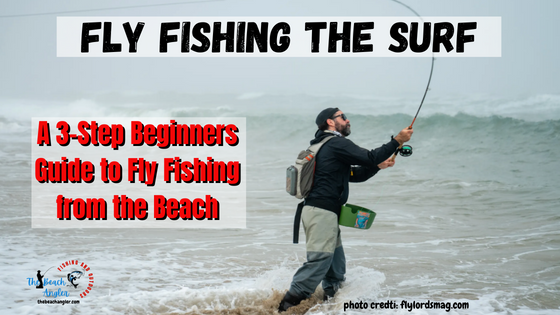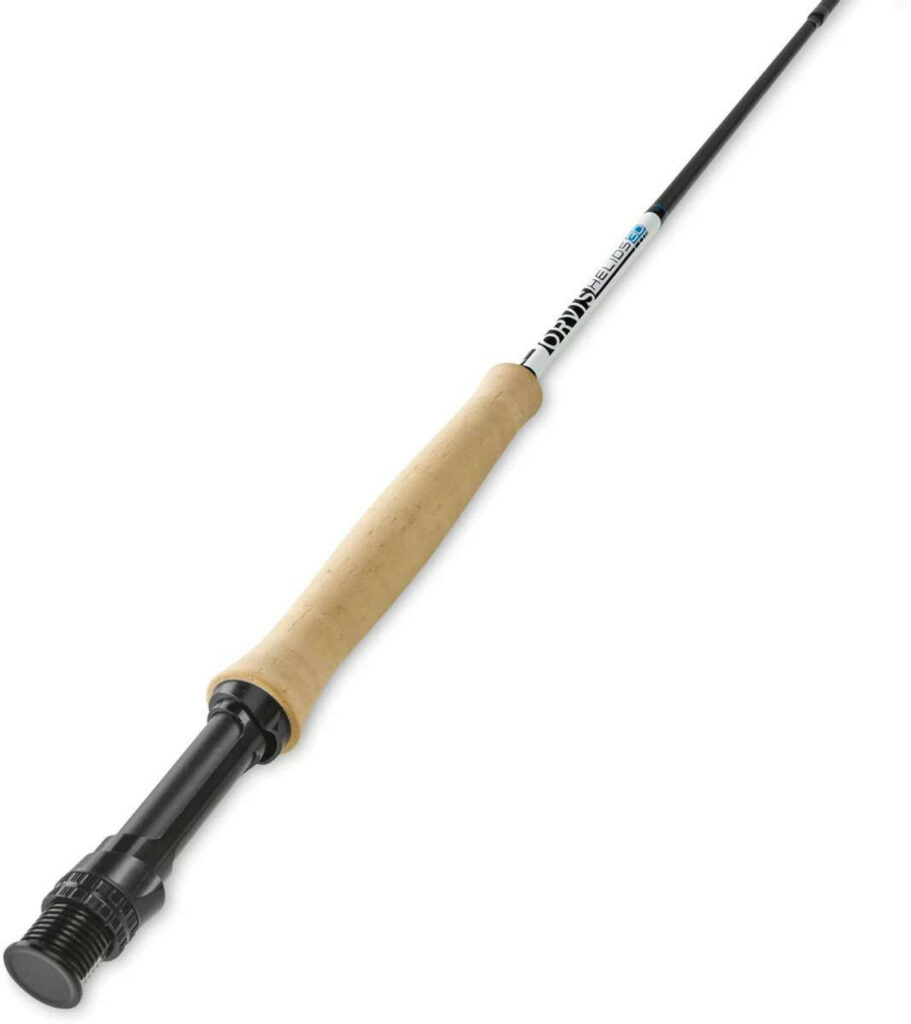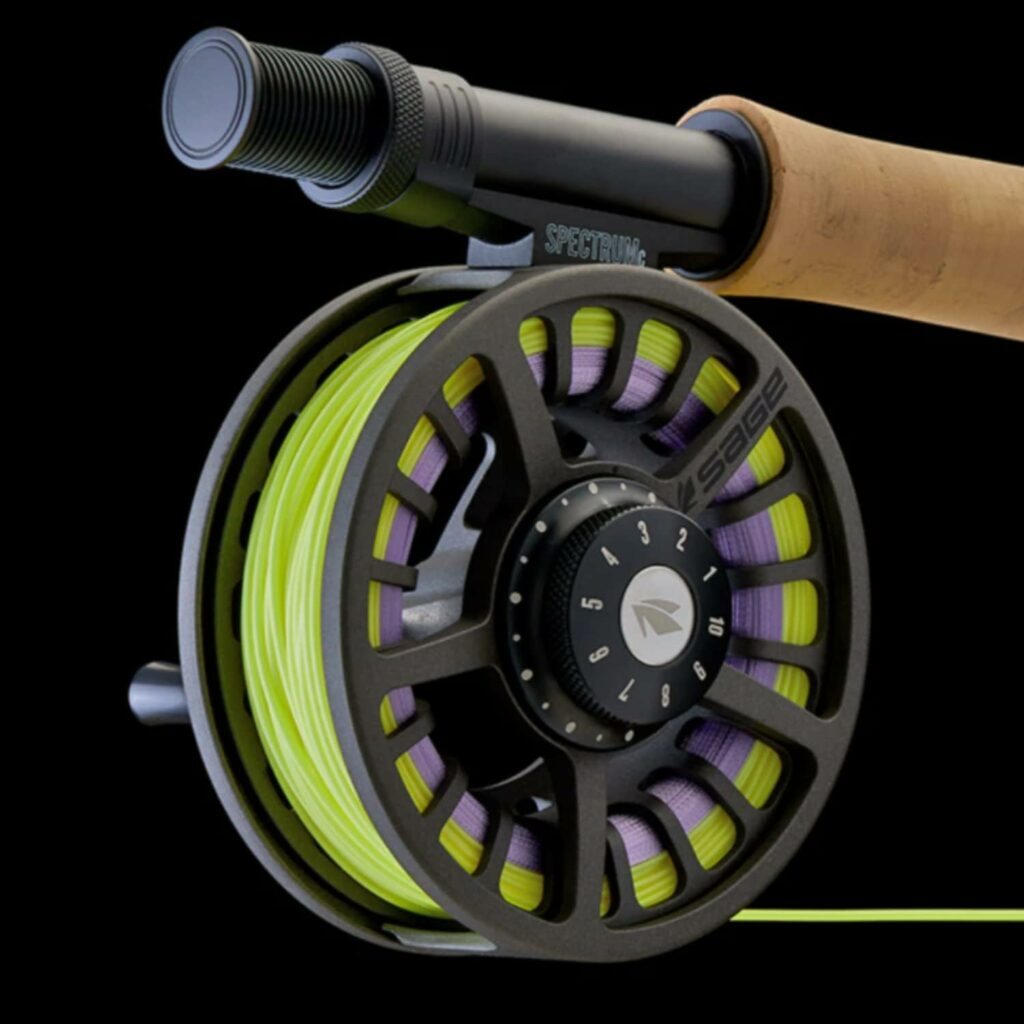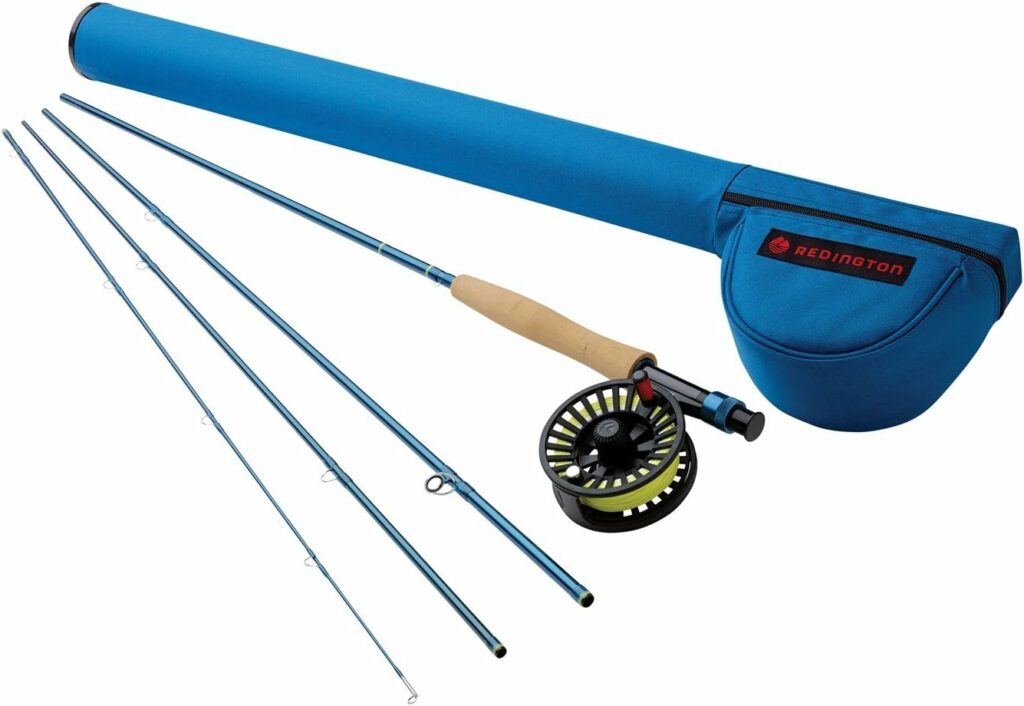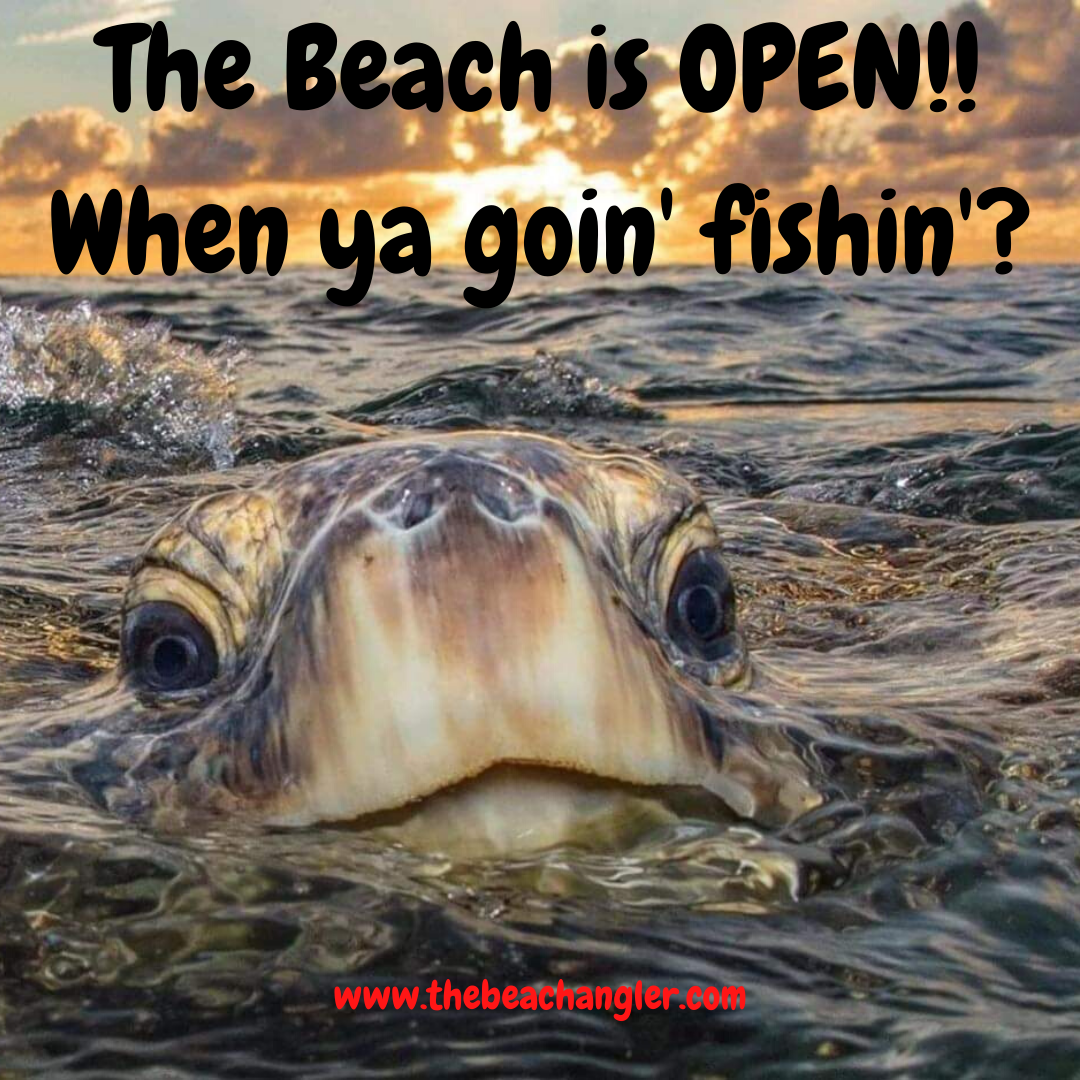When it comes to fly fishing, one often envisions tranquil rivers or serene lakes. However, there’s another dimension to this thrilling sport that offers an entirely different experience: fly fishing the surf. Combining the art of fly casting, the excitement of catching fish, and the power of the ocean, fly fishing the surf presents anglers with a unique set of challenges and opportunities making it a truly unique and awesome experience.
Quick Look:
Fly fishing the surf refers to the practice of casting a fly rod and artificial fly into the breaking waves along the shoreline. This method allows anglers to target a variety of species, including striped bass, bluefish, redfish, and more. Unlike traditional fly fishing, the surf introduces elements such as tides, currents, and wave action, making it an exciting and dynamic pursuit. This 3-step guide will help you get started on the right foot on your journey of fly fishing the surf. 1. Get the right equipment, 2. learn fly-casting techniques, 3. Learn to read the surf.
If you’re a fishing junkie, like me, who is looking to level up your angling game, then why not give fly fishing the surf a try?
What we will cover here is designed specifically for beginners who are eager to dive into the world of fly fishing the surf.
I learned to fly fish at a very young age, and I enjoy the challenge catching fish with the old stick and string. 
Follow along and we’ll dive into the world of fly fishing the surf, exploring the techniques, gear, and strategies that will help you make the most of your surf fly fishing adventures.

Understanding Fly Fishing the Surf
What is Fly Fishing?
Fly fishing is a distinct method of angling that involves casting a lightweight artificial fly using a specialized fly rod, reel, and line. This technique mimics the appearance and movement of insects or other small creatures that fish feed on, enticing them to strike. It requires skill, precision, an understanding of fish behavior, and practice.
Fly Fishing from the Beach
Fly fishing from the beach offers a unique experience compared to other forms of fishing. It combines the serenity of the beach environment with the excitement of fly fishing, creating a unique blend of nature and sport.
The vast expanse of the ocean, the rhythmic sound of waves crashing, the challenge of catching and landing fish, and physical demands of navigating the surf and casting for extended periods make it an unforgettable adventure.
Beach fly fishing provides a versatile fishing experience, allowing you to target a wide range of species that roam the surf zone. Some of these can be very large and powerful. Each species presents its own challenges and rewards, adding excitement and diversity to your fishing adventure.
Fly Fishing the Surf for Beginners: Getting Started
So you’ve decided to give fly fishing the surf a shot? Fantastic! Let’s get you started on the right foot. But first, before we get ahead of ourselves, let’s take a moment to understand what fly fishing the surf is all about. Fly fishing in the surf involves casting a specially designed fly into the ocean from the shoreline in order to lure fish.
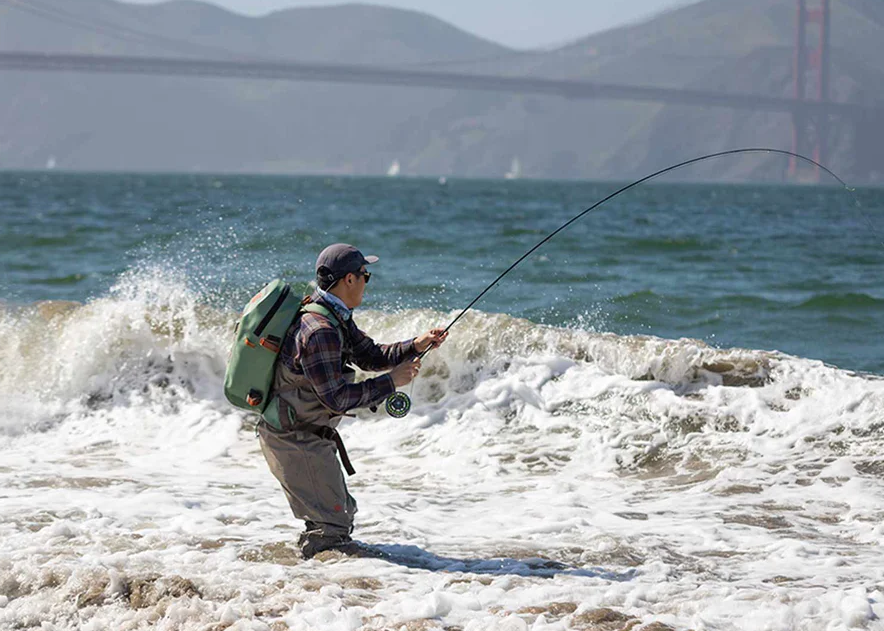
Unlike traditional fishing methods, where the weight of the bait or lure does most of the work, fly fishing relies on the weight and momentum of the fly line to carry the fly to the desired location.
It requires skill, patience, and a keen sense of observation to be successful in this sport. Here are some of the essentials for a beginner just learning to fly fishing the surf:
Surf Fly Fishing Gear Versus Freshwater Fly Fishing Gear
Saltwater fly fishing rods and reels, also known as saltwater fly tackle, are specifically designed to handle the challenges and demands of saltwater fishing. Here are the key differences between saltwater fly fishing rods and reels compared to regular fly fishing tackle:
- Material and Construction: Saltwater fly rods and reels are typically constructed with corrosion-resistant materials such as graphite or high-quality alloys to withstand the corrosive nature of saltwater. They are built to be more durable and robust compared to regular fly fishing tackle.
- Size and Weight: Saltwater fly rods and reels are generally heavier and more substantial than their freshwater counterparts. This added weight helps in casting larger flies and handling stronger fish that are commonly found in saltwater environments.
- Line Weight and Strength: Saltwater fly fishing tackle is designed to handle heavier line weights to handle larger fish species and strong saltwater currents. The fly lines used in saltwater fly fishing are typically heavier and have a higher breaking strength compared to those used in freshwater fly fishing.
- Drag Systems: Saltwater fly reels are equipped with more powerful drag systems to handle the fast runs and powerful bursts of large saltwater fish. The drag systems are designed to provide smooth and consistent resistance to prevent the fish from breaking the line.
- Corrosion Resistance: Saltwater environments are harsh and can cause corrosion to fishing tackle. Saltwater fly reels often have sealed drag systems and are made with corrosion-resistant materials to prevent damage caused by exposure to saltwater.
- Line Retrieval Rates: Saltwater fly reels are designed with faster line retrieval rates to quickly retrieve line when fighting fast-swimming saltwater fish. This helps in keeping tension on the fish and reducing the chances of the line going slack.
- Saltwater-Specific Features: Some saltwater fly fishing rods and reels may include additional features such as extended fighting butts on the rod handles to provide leverage when battling large fish, larger arbors on reels for quicker line retrieval, and additional protection against sand and debris.
It’s important to note that while saltwater fly fishing tackle is designed specifically for saltwater conditions, it can still be used in freshwater environments.
However, using regular freshwater fly fishing tackle in saltwater can lead to corrosion and damage to the equipment due to the corrosive properties of saltwater.
Step 1: Choose the Right Equipment
To tackle the challenges of the surf, specialized gear and equipment are essential When it comes to fly fishing the surf, having the right equipment is crucial. Here’s a checklist of what you’ll need:
Fly rod: Opt for a sturdy fly rod, preferably in the 8 to 10-foot range, with a weight rating suitable for the species you intend to target.l. A sturdy saltwater fly rod in the 8 to 10-weight range provides the necessary backbone to handle larger fish and withstand the harsh environment.
Paired with a quality reel, a weight-forward floating fly line, and a leader designed for saltwater conditions, you’ll be well-equipped to tackle the surf. Additionally, proper clothing, including waders, boots, and a wading belt, ensures comfort and safety while navigating the shoreline.
Fly reel: Select a reel that matches the weight of your fly rod and has a smooth drag system. When selecting a fly rod for beach fishing, choose a versatile rod that can handle different conditions and fish species. A 9 to 10-foot rod with a weight rating between 7 and 9 is recommended. Pair it with a high-quality fly reel that has a smooth drag system to handle powerful runs.
Fly line: Invest in a high-quality saltwater fly line that suits the conditions of the surf you’ll be fishing in. Fly lines designed for saltwater use are essential for beach fly fishing. These lines have a specialized coating to withstand the corrosive nature of saltwater and shoot through the guides smoothly. Choose a weight-forward floating line for most beach fishing situations.
Leaders and tippets: Use strong leaders and tippets, preferably made of fluorocarbon, to handle the abrasive saltwater environment.
Flies: Choosing the right fly for surf fishing depends on various factors, such as the target species, water conditions, and local baitfish. Choose flies that mimic the local baitfish or other prey species found in the surf. Clouser Minnows, Deceivers, and Surf Candies are popular patterns that imitate baitfish and are effective in enticing predatory fish.
Selecting the right flies is crucial for success in fly fishing from the beach. Carry a variety of patterns that imitate baitfish, crustaceans, and other prevalent prey species. It’s important to experiment with different colors, sizes, and retrieval speeds to find what works best on any given day.
Waders and boots: Ensure you have breathable waders and sturdy boots to keep you comfortable and safe while wading in the surf. Invest in a pair of high-quality waders and boots suitable for saltwater use. These will keep you dry and comfortable while allowing you to access fish-holding areas that are unreachable from the shore.
Polarized sunglasses: Protect your eyes and improve visibility by wearing polarized sunglasses. Don’t forget to bring essential accessories such as polarized sunglasses, a hat for sun protection, a stripping basket to manage fly line, a landing net, and a reliable sunscreen.
Step 2: Learn Fly Fishing Casting Techniques
Mastering the art of casting is essential for fly fishing the surf. The open beach environment often necessitates longer casts, and techniques like the double haul and the Belgium cast can help achieve greater distance and accuracy.
Mastering efficient casting techniques is essential for accurate and long-distance casts. Practice these techniques in different wind conditions to improve your accuracy and presentation before heading to the surf. This will increase your chances of landing fish and avoid a lot of frustration.
In the surf, you’ll encounter various casting challenges due to the wind, waves, and the weight of the fly line. Here are a few casting techniques to practice:

- Overhead cast: The most basic and widely used cast in fly fishing, the overhead cast involves bringing the rod behind you and casting the line forward in a fluid motion.
- Roll cast: Ideal for tight spaces or when the wind is blowing in your face, the roll cast involves lifting the line from the water’s surface and rolling it forward using the rod’s motion.
- Double haul: A more advanced technique, the double haul allows you to cast longer distances by using both your rod hand and line hand to generate extra line speed.
Step 3: Learn to Read and Understanding the Surf
Understanding the behavior of the surf is crucial for successful fly fishing. Observing wave patterns, wave breaks, and areas of turbulence can provide valuable insights into where fish are likely to be feeding. Identifying sandbars, troughs, and rips allows anglers to locate productive areas and target fish with precision.
Observing the water’s surface can provide valuable clues about where fish are holding. Look for signs of baitfish activity, birds diving, or disturbances on the surface indicating the presence of feeding fish. Knowing how to read the surf conditions is crucial for a successful fly fishing experience. Here are a few factors to consider:
- Tides: Understanding the tide and current patterns is crucial for successful beach fly fishing. Fish are often more active during certain stages of the tide. Pay attention to the tide charts and fish during incoming or outgoing tides when the water movement is more active, attracting fish.
- Structure: Look for areas with natural features like sandbars, jetties, or rocks, as they create currents and provide shelter for fish.
- Baitfish: Keep an eye out for schools of baitfish, as predatory fish are likely to be nearby.
- Wave patterns: Observe the wave patterns and identify troughs, points, rips or suck outs, and holes where fish may be feeding or seeking refuge.
Challenges and Tips for Fly Fishing the Surf
Fly fishing the surf presents unique challenges, including dealing with wind, managing waves, and currents. To overcome these obstacles, consider using heavier flies and sinking lines to maintain control in turbulent waters. Additionally, wearing polarized sunglasses can improve visibility and help spot fish in the surf.
Tips for Locating Fish
Locating fish in the vast expanse of the surf can be challenging. Looking for signs of baitfish activity, such as diving birds or breaking water, can indicate the presence of feeding fish. Look for areas known to hold fish, such as rocky points, sandbars, jetties, or submerged structure.
These features provide shelter and feeding opportunities for fish. Pay attention to the beach’s topography, as variations in depth and contour can significantly impact your chances of hooking a fish. Online fishing forums, local fishing reports, and discussions with experienced local anglers can provide valuable insights.
Presentation Strategies
Once you’ve located fish, using proper fly retrieval methods is crucial. Presenting the fly in an enticing manner is key to enticing strikes from fish in the surf. Stripping the line using short, quick pulls imitates the darting motion of baitfish and can entice strikes. Alternatively, using a steady retrieve can simulate the swimming action of larger prey and draw attention from predatory fish.
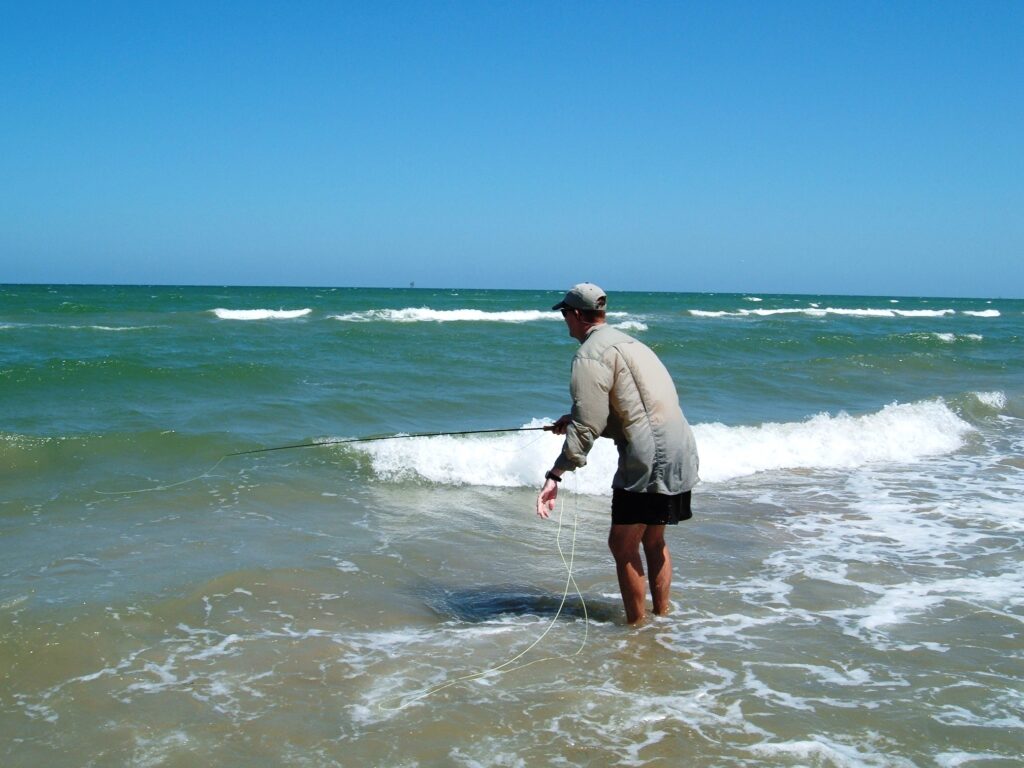
Varying the retrieve speed and depth can imitate injured prey and elicit aggressive strikes from fish.
Experiment with different retrieval techniques, including steady retrieves, strip-and-pause, and erratic retrieves. Vary your retrieve speed and depth to trigger strikes from fish.
Safety Considerations
As with any water-based activity, safety should be a top priority when fly fishing the surf. It’s important to be aware of tides, currents, and changing weather conditions. Wearing a personal flotation device (PFD) and avoiding fishing alone can significantly reduce the risks associated with surf fishing.
Check weather forecasts and be aware of changing conditions. Avoid fishing during storms or when lightning is present. Dress appropriately for the weather and always prioritize your safety.
Beach Fly Fishing Etiquette
When fishing from a crowded beach, maintain proper spacing between fellow anglers to avoid tangling lines. Be courteous and respectful of other people enjoying the beach. Please clean up after yourself and try to leave the beach cleaner than you found it. Dispose of any trash properly and avoid disturbing the natural environment.
Practice responsible angling by keeping only what you can use and adhering to catch-and-release practices with the rest. Handle fish gently and minimize their time out of the water. Follow local regulations regarding size limits and bag limits to help preserve fish populations for future generations.
8 Top Surf Fly Fishing Destinations
When it comes to fly fishing in the surf, there are several fantastic destinations around the world that offer great opportunities for this exhilarating sport. From the picturesque beaches of Cape Cod to the rugged coastlines of Oregon, there are numerous destinations worldwide that offer exceptional surf fly fishing opportunities.
Each location presents its own unique challenges and rewards, providing anglers with unforgettable experiences and the chance to target various species. Here are some of the best destinations to try fly fishing in the surf:
Montauk, New York, USA: Located at the eastern tip of Long Island, Montauk is renowned for its excellent saltwater fly fishing. The area is known for its abundant striped bass, bluefish, and false albacore populations, making it a popular destination for anglers seeking thrilling surf fly fishing experiences.
Cape Cod, Massachusetts, USA: Cape Cod offers a diverse range of surf fly fishing opportunities. The region is known for its striped bass fishing, particularly during their annual migrations. You can also target bluefish, bonito, and false albacore in the surf along the Cape’s beautiful beaches.
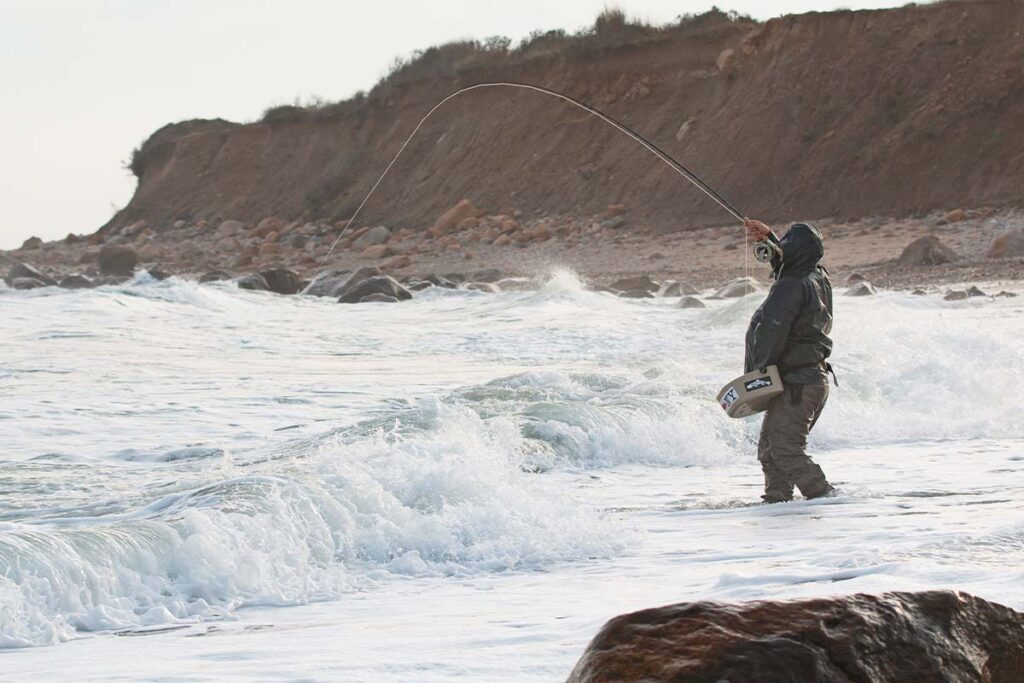
Outer Banks, North Carolina, USA: The Outer Banks is a 200-mile stretch of barrier islands known for its superb surf fishing. Anglers flock here for the chance to catch red drum, striped bass, bluefish, and Spanish mackerel in the surf. The expansive beaches and changing tides provide excellent conditions for fly fishing.
Padre Island National Seashore, Texas, USA: My home waters of Padre Island offer 60 miles of remote beach with awesome fishing opportunities for speckled trout, redfish, pompano, Spanish mackerel, jack crevalle and more. Plenty of room for fly fishing the surf away from the crowds.

Christmas Island, Kiribati: Located in the Pacific Ocean, Christmas Island is a remote fly fishing paradise. The island’s flats and reefs are teeming with bonefish, trevally, triggerfish, and other species.
The surf fishing here offers an unforgettable experience, with opportunities to target powerful fish in pristine tropical waters.
Seychelles: This stunning archipelago in the Indian Ocean is famous for its saltwater fly fishing. With its white sandy beaches, crystal-clear waters, and abundant marine life, Seychelles offers excellent opportunities to catch species like bonefish, giant trevally, permit, and milkfish in the surf.
New Zealand: New Zealand is renowned for its pristine rivers and lakes, but it also boasts excellent surf fly fishing along its coastline. With species like brown trout, kahawai, and salmon available in the surf, the South Island’s rugged coastline and the North Island’s estuaries offer exciting opportunities for fly fishing enthusiasts.
Baja California, Mexico: The Baja Peninsula offers exceptional fly fishing in the surf, particularly along the East Cape and in the vicinity of Cabo San Lucas. Anglers can target roosterfish, jacks, snook, and other species in the area’s warm waters, while enjoying the stunning coastal scenery.
These are just some of the better beaches to try fly fishing the surf. There are many more all across the world. If you have a favorite, drop it in the comments below and share it with us. Remember to research local regulations, obtain necessary licenses, and consult with local guides or experienced anglers to ensure you have the best possible experience when fly fishing the surf.
What can You Catch when Fly Fishing the Surf?
When fly fishing in the surf, there are several common fish species you can target. While the availability of fish can vary depending on your location and time of year, here are some of the most commonly caught fish when fly fishing the surf in the USA.
Striped Bass: Striped bass are highly sought after by fly anglers in the surf. They are known for their aggressive strikes and strong fights. These fish can grow quite large, providing an exciting challenge for fly fishermen.

Bluefish: Bluefish are known for their aggressive nature and powerful runs. They are often found in the surf and can be targeted with a variety of fly patterns. Bluefish are known for their sharp teeth, so it’s important to use a wire leader to prevent bite-offs.
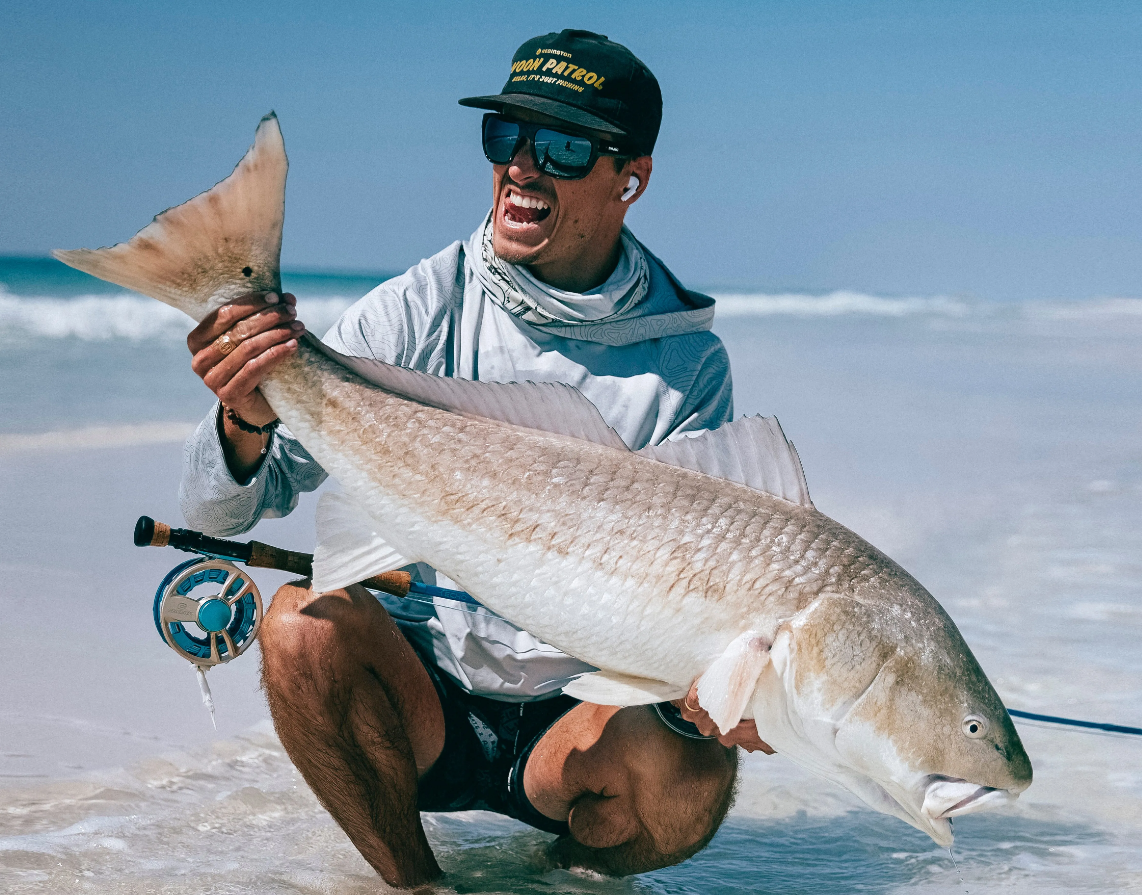
Redfish (Red Drum): Redfish are popular targets for fly anglers in coastal areas. They are known for their copper-colored bodies and powerful fights. Redfish can be found in the surf zone, particularly in shallow waters and around structures like jetties or sandbars.
Flounder: Flounder are bottom-dwelling fish commonly found in sandy areas near the surf. They are known for their flat bodies and can be targeted by presenting flies near the bottom. Flounder can provide exciting action and are often prized for their delicious meat.
Weakfish (Sea Trout): Weakfish are another species commonly targeted by fly anglers in the surf. They are known for their beautiful markings and are often caught during their migratory runs. Weakfish can be found near sandy beaches and inlet areas.
Pompano: Pompano are highly regarded for their delicious flesh and can be targeted with flies in the surf. They are commonly found in sandy areas and are known for their strong fighting ability.
It’s important to note that fish availability can vary based on location, season, and local regulations. It’s always a good idea to check with local fishing authorities or consult with experienced anglers in the area you plan to fish to get the most up-to-date information on the prevalent fish species, what flies are catching fish, and when and where you can find the most action.
Fly Fishing the Surf Frequently Asked Questions
Can I use my freshwater fly fishing equipment in the surf?
It’s generally not recommended to use freshwater fly fishing equipment in the surf due to the corrosive nature of saltwater. Saltwater-specific gear is designed to withstand the harsh conditions of the surf.
What species of fish can I catch while fly fishing in the surf?
The surf offers a wide variety of fish species, including striped bass, bluefish, redfish, snook, and more. Research the local surf species in your area to know what you can target. The fish species you can target while fly fishing from the beach depend on your location. Common species include striped bass, bluefish, redfish, bonefish, and various other saltwater game fish.
What flies should I use for fly fishing the surf?
Flies that imitate baitfish, shrimp, crabs, or other prey species found in the surf are usually effective. Popular fly patterns for the surf include Clouser Minnows, Deceivers, and Surf Candies.
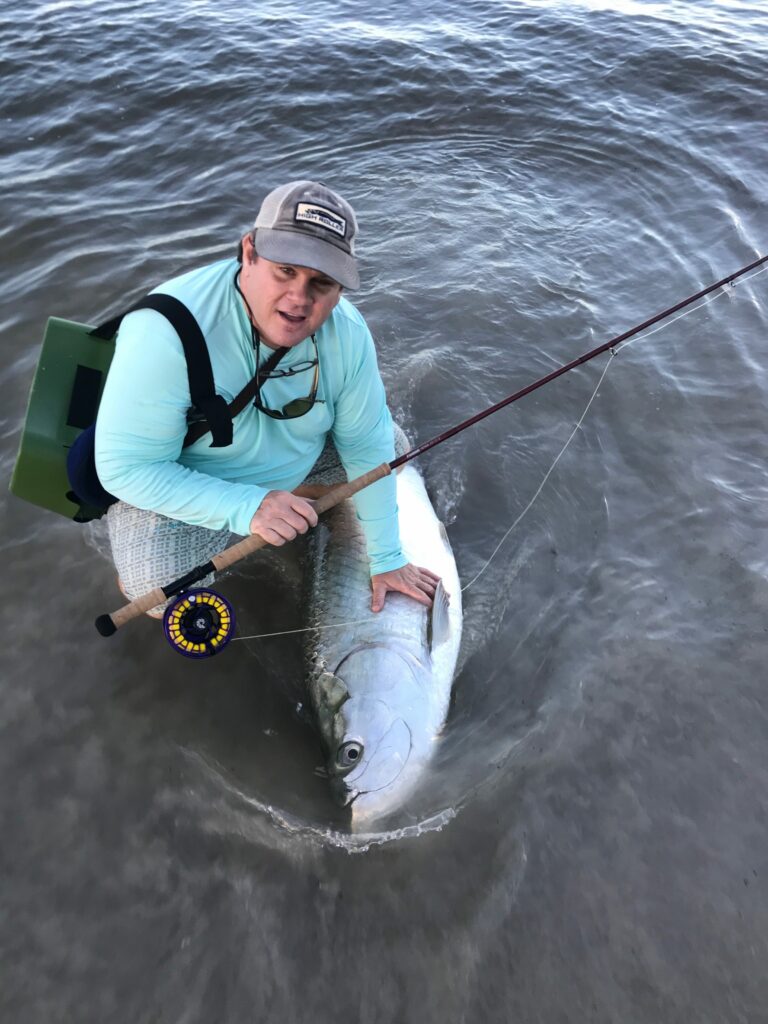
Do I need to wear waders while fly fishing the surf?
Waders are highly recommended when fly fishing the surf as they keep you dry, provide insulation, and protect you from sharp objects in the water.
Is it safe to wade in the surf?
Wading in the surf can be safe if you take proper precautions. Always assess the surf conditions, wear appropriate gear, and be mindful of your surroundings. It’s also advisable to fish with a buddy for added safety.

Do I need specialized gear for fly fishing the surf?
Yes, specialized gear such as a sturdy saltwater fly rod, appropriate fly line, and saltwater-resistant reels are necessary for fly fishing the surf.
Are there any safety considerations I should be aware of?
Absolutely. It’s crucial to stay informed about tides, currents, and changing weather conditions. Wearing a personal flotation device (PFD) and fishing with a partner can enhance safety.
How can I locate fish in the surf?
Look for signs of baitfish activity, observe tidal movements, and focus on areas with structure such as jetties or sandbars to locate fish in the surf.
Do I need to be an experienced angler to try fly fishing from the beach?
Fly fishing from the beach can be enjoyed by anglers of all skill levels. However, some prior knowledge of casting techniques and fish behavior can enhance your chances of success.
Is it possible to fly fish from any beach?
While it is possible to fly fish from many beaches, some locations are more conducive to this activity due to factors such as access, structure, and fish populations. Researching and selecting the right beach will greatly improve your chances of success.
Fly Fishing the Surf: Try Something New
Fly fishing the surf opens up a whole new world of excitement and adventure. With the right equipment, casting techniques, and understanding of the surf, you’ll be well on your way to catching fish from the surf with fly fishing gear. Remember to respect the environment, practice catch-and-release, and continue honing your skills as you embark on this thrilling angling journey.
Once you try it, you’ll find fly fishing the surf to be a captivating fishing method that combines the artistry of fly casting with the power and unpredictability of the ocean.
By embracing the unique challenges and opportunities presented by the surf, fly anglers can unlock a whole new world of fishing adventures.
When fly fishing the surf, you can enjoy a rewarding day of fishing while surrounded by the beauty of the beach, the ocean breeze, and catching fish. So, grab your fly rod, head to the beach,

As always, stay safe, enjoy the journey and please try to leave it cleaner than you found it. If you have any comments, questions, ideas or suggestions please leave them in the comment section below and I’ll get back to you asap. You can follow us on Facebook: Rex The Beach Angler, Instagram: thebeachangler7, Twitter: @AnglerBeach, and YouTube: Man Art Creations.
P.S. – Thanks so much for checking out our blog we really appreciate it. Just so you know, we may receive a commission if you click on some of the links that appear on our site. This helps us keep our content free and up-to-date for everyone. We appreciate your support!
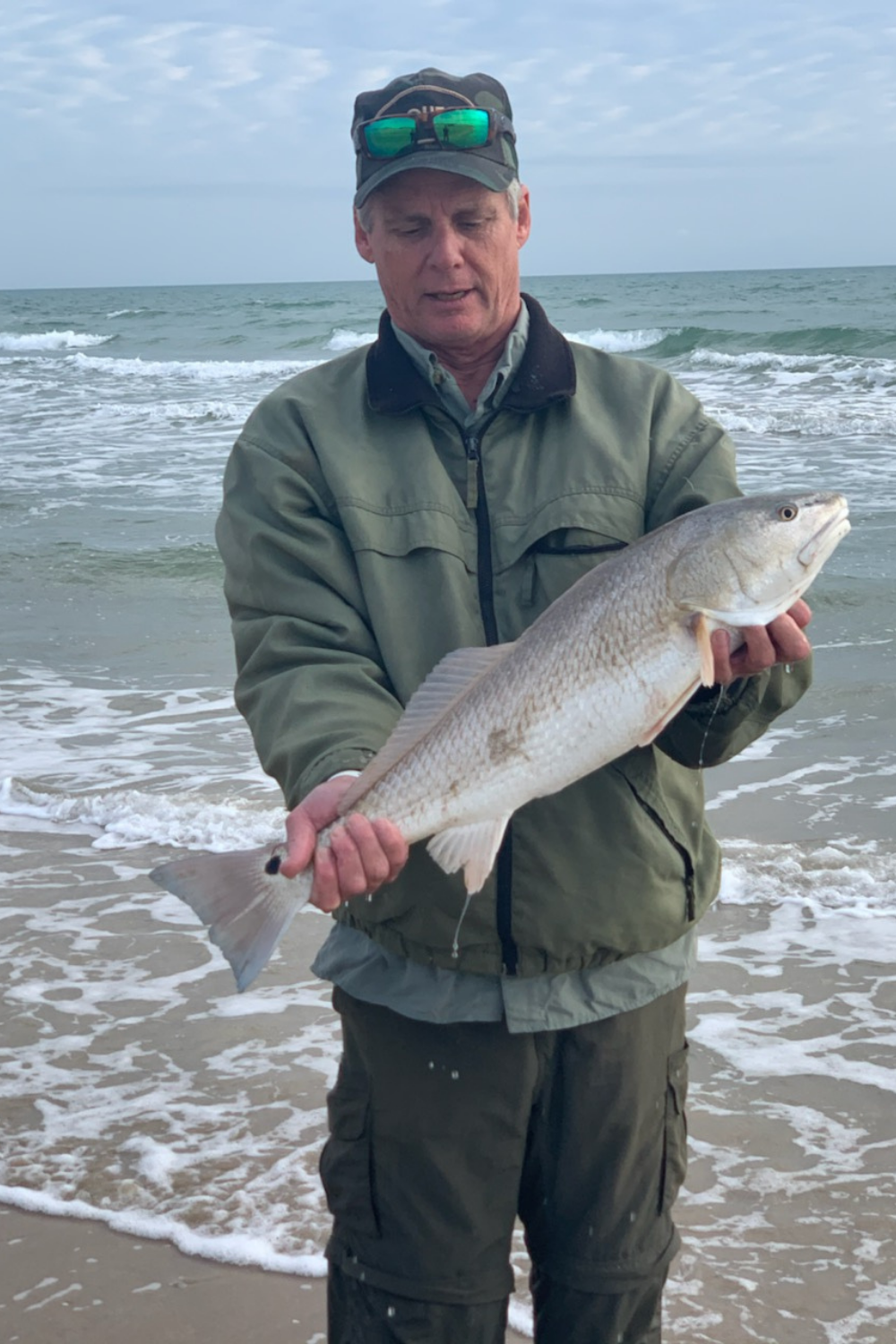
A life long surf fisherman with 50+ years of experience, I am also an avid hunter and outdoorsman. I will be sharing my passion for the outdoors with you so be prepared for hunting, fishing, camping, hiking and more. Along with gear reviews and the latest trends and innovations in the outdoor industry.
